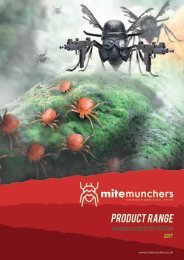MM Catalog7
You also want an ePaper? Increase the reach of your titles
YUMPU automatically turns print PDFs into web optimized ePapers that Google loves.
APHID preditors<br />
Nesidiocoris Tenuis<br />
Type: Predatory Bug<br />
How it works: Nesidiocoris is voracious & hungry. It is<br />
a generalist predator. Very fast moving and a major<br />
natural enemy of pests such as whiteflies, moth eggs<br />
and other small grubs. Also enjoys feeding on other<br />
pests such as thrips, two spotted mite and aphids,<br />
making it one of the best generalist predators on the<br />
market!<br />
They tend to blend very well with plant material and<br />
like to hide, so can be difficult to see. Eggs are laid<br />
into the plant tissue and cannot be seen with the<br />
naked eye. Eggs hatch after about 7 days depending<br />
on temperature, nymphs take approximately 14 days<br />
to develop into adults. Nesidiocoris has a shorter life<br />
cycle when it feeds on eggs and larvae of whitefly or<br />
moths, than when feeding predominantly on thrips<br />
or a wide varieties of mites.<br />
They breed quickly at temperatures of 23°C and<br />
above, but generations are much slower below 20°C.<br />
Both adults and nymphs feed on pests.<br />
Species controlled: aphids, spidermite, thrips, most<br />
larvae & most other soft bodied prey<br />
Application: To apply simply sprinkle the contents<br />
of bottles evenly over the tops of the plants.<br />
10-20mL of media per release point is recommended<br />
to increase mating. When pest levels are initially low<br />
it is suggested to first apply sterilised Ephestia moth<br />
eggs over the crop to give Nesidiocoris a food source<br />
and improve initial establishment. Releases should<br />
ideally occur in low light conditions, preferably early<br />
morning or late evening to reduce possible losses of<br />
adults flying directly to vents.<br />
IMPORTANT NOTICE<br />
Nesidiocoris will feed on plant tissues. Symptoms<br />
due to plant feeding are common and tend to<br />
occur in the following situations:<br />
When there is little or no prey available and<br />
Nesidiocoris numbers are moderate to high<br />
If high numbers of predatory bugs are present in<br />
the growing points of plants<br />
In hot weather conditions Nesidiocoris will breed<br />
more quickly and take more moisture from plants<br />
Common feeding symptoms include:<br />
Spotting and holes in new leaves<br />
Necrotic feeding rings on soft plant stems and<br />
flower petioles<br />
Some signs of feeding are normal and are expected.<br />
Minor to moderate symptoms will not cause<br />
damage and are a sign of good predator levels in<br />
your crop. Economic damage can be avoided by<br />
regular monitoring. If Nesidiocoris reach high<br />
levels and numbers are not lowered, economic<br />
damage may occur including:<br />
Necrotic rings in the main stem near the heads<br />
Flower drop<br />
Uneven setting<br />
Feeding spots on fruit<br />
Irregular shaped flowers and/or fruit<br />
This can be easily controlled by introducing moth<br />
eggs as an additional food source in the absence of<br />
pests.<br />
NESIDIOCORIS TENUIS<br />
250 ADULTS AND LARVAE<br />
£38.50<br />
NESIDIOCORIS TENUIS<br />
500 ADULTS AND LARVAE<br />
£48.50<br />
5











